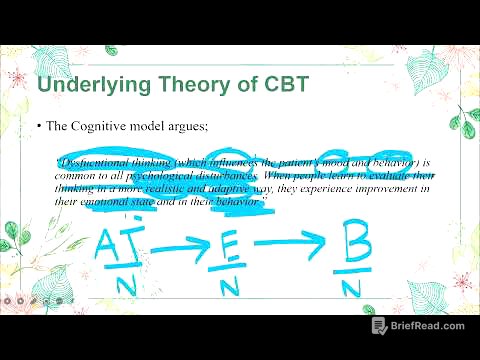TLDR;
Judith S. Beck's "Cognitive Behavior Therapy: Basics and Beyond" is a guide to understanding and applying CBT principles. The book covers the theoretical foundations of CBT, including the cognitive model and the role of cognitions in emotional and behavioral disorders. It also details basic and advanced CBT techniques, such as cognitive restructuring, exposure therapy, and behavioral activation. Additionally, it addresses the importance of the therapeutic relationship and methods for evaluating progress in CBT.
- Introduces CBT as a therapeutic approach focusing on the interconnection of thoughts, feelings, and behaviors.
- Explores cognitive distortions and maladaptive thinking and their impact on emotional and behavioral issues.
- Covers assessment and case conceptualization, cognitive restructuring, and behavioral techniques.
- Discusses advanced cognitive techniques and the application of CBT for specific populations.
- Emphasizes the therapeutic relationship and methods for evaluating progress in CBT.
Introduction: Understanding CBT [0:33]
Judith S. Beck introduces Cognitive Behavioral Therapy (CBT) as a therapeutic approach. CBT operates on the principle that thoughts, feelings, and behaviors are interconnected. The primary goal of CBT is to assist individuals in recognizing and modifying distorted thinking patterns and maladaptive behaviors. This modification aims to improve emotional regulation and enhance problem-solving skills.
Part One: Theoretical Foundations - Chapter One: The Cognitive Model [1:17]
This chapter outlines the cognitive model of therapy. The model posits that cognitive distortions and maladaptive thinking contribute to emotional and behavioral issues. Identifying and challenging these cognitive distortions can lead to symptom relief and improved functioning. Cognitive distortions are systematic errors in thinking that contribute to emotional distress and maladaptive behaviors. The cognitive model is the framework used in CBT to understand and address these distortions.
Chapter Two: The Role of Cognitions in Emotional and Behavioral Disorders [1:56]
Beck explores the role of cognitive processes in various emotional and behavioral disorders, including depression, anxiety, and personality disorders. Distorted thinking patterns contribute to the maintenance of these conditions. Addressing these patterns in therapy is crucial. Cognitive processes refer to the ways in which thinking patterns influence emotional and behavioral disorders. Specific cognitive distortions are related to different psychological conditions.
Part Two: Basic CBT Techniques - Chapter Three: Assessment and Case Conceptualization [2:36]
This chapter focuses on the initial assessment and case conceptualization process in CBT. Gathering information about the client's presenting problems, cognitive distortions, and life context is essential. This information helps to develop an effective treatment plan. Assessment involves gathering and analyzing information to understand the client's issues and needs. Case conceptualization involves developing a framework for understanding and addressing the client's problems.
Chapter Four: Cognitive Restructuring [3:13]
Beck introduces cognitive restructuring techniques. These techniques aim to identify and challenge distorted thoughts. Practical strategies help clients reframe negative thinking patterns and develop more balanced and realistic thoughts. Cognitive restructuring involves techniques for altering maladaptive thinking patterns. Methods for addressing and modifying cognitive distortions are key to this process.
Chapter Five: Behavioral Techniques [3:43]
This chapter covers behavioral techniques used in CBT, such as exposure therapy, behavioral activation, and skills training. These techniques can be integrated with cognitive interventions to address both cognitive and behavioral aspects of disorders. Exposure therapy involves gradual exposure to feared situations to reduce anxiety and avoidance behaviors. Behavioral activation includes strategies for increasing engagement in pleasurable and meaningful activities.
Part Three: Advanced CBT Techniques and Applications - Chapter Six: Advanced Cognitive Techniques [4:15]
Beck discusses advanced cognitive techniques for addressing complex cognitive distortions and enhancing therapeutic outcomes. Examples of how these techniques can be applied in various clinical contexts are provided. Advanced cognitive techniques are used for addressing more challenging cognitive distortions. These techniques find application in different therapeutic settings.
Chapter Seven: CBT for Specific Populations [4:49]
This chapter explores the application of CBT for specific populations, including children, adolescents, and individuals with complex or chronic conditions. Adaptations and considerations necessary for working with diverse client groups are discussed. CBT techniques are tailored for different age groups and conditions. Modifications to CBT approaches are made for specific client needs.
Part Four: The Practice of CBT - Chapter Eight: The Therapeutic Relationship [5:21]
Beck emphasizes the importance of the therapeutic relationship in CBT. Building rapport, maintaining empathy, and fostering collaboration are essential for successful outcomes in therapy. The therapist-client relationship plays a crucial role in effective CBT. Empathy and rapport are vital for building trust and understanding in the therapeutic process.
Chapter Nine: Evaluating and Measuring Progress [5:47]
This chapter focuses on methods for evaluating and measuring progress in CBT. Strategies for assessing treatment effectiveness and making adjustments based on client feedback and outcomes are provided. Evaluation involves assessing the effectiveness of CBT interventions. Measurement includes using tools and methods to track progress and outcomes.
Conclusion: The Future of CBT [6:15]
Judith S. Beck concludes by reflecting on the evolution of CBT and its future directions. The continued importance of research, training, and practice in advancing the field and improving therapeutic outcomes is emphasized. "Cognitive Behavioral Therapy: Basics and Beyond" serves as a valuable resource for both novice and experienced clinicians, providing practical guidance for implementing CBT in various clinical settings.






![Baray Bhaiya Episode 74 - [Eng Sub] - Aijaz Aslam - Maya Khan - Rabya Kulsoom - 28th August 2025](https://wm-img.halpindev.com/p-briefread_c-10_b-10/urlb/aHR0cDovL2ltZy55b3V0dWJlLmNvbS92aS9vdHFoeWxDV01ERS9ocWRlZmF1bHQuanBn.jpg)


